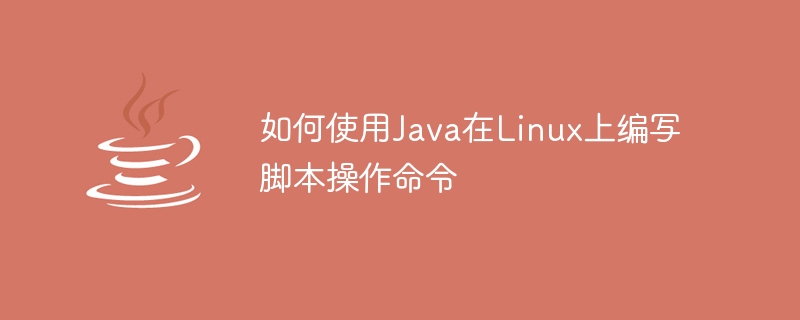Home >Java >javaTutorial >How to script action commands on Linux using Java
How to script action commands on Linux using Java
- WBOYWBOYWBOYWBOYWBOYWBOYWBOYWBOYWBOYWBOYWBOYWBOYWBOriginal
- 2023-10-05 08:01:411410browse

How to use Java to write script operation commands on Linux requires specific code examples
In Linux systems, we often need to perform various operations through the command line, For example, create files, move files, delete files, etc. Normally we use Shell scripts to complete these operations. However, in some specific cases, we may want to write scripts in Java to manipulate commands. This article will introduce how to use Java to write script operation commands on Linux and provide specific code examples.
We first need to set up the Java running environment and import related classes. In Linux systems, we can install OpenJDK through the following command:
sudo apt-get update sudo apt-get install default-jdk
After the installation is complete, we can use Java's Runtime class to execute commands. Below is a simple example that demonstrates how to create a directory using Java.
import java.io.*;
public class CommandScript {
public static void main(String[] args) {
try {
String command = "mkdir test_directory";
Process process = Runtime.getRuntime().exec(command);
process.waitFor(); // 等待命令执行完成
System.out.println("目录创建完成");
} catch (IOException e) {
e.printStackTrace();
} catch (InterruptedException e) {
e.printStackTrace();
}
}
}In the above example, we used the Runtime.getRuntime().exec() method to execute the command. In this example, we use the mkdir test_directory command to create a directory named test_directory. process.waitFor()The method is used to wait for command execution to complete. After the directory creation is complete, we print a message.
In addition to creating directories, we can also use Java to execute other commands, such as moving files, copying files, deleting files, etc. Here is an example of moving a file:
import java.io.*;
public class CommandScript {
public static void main(String[] args) {
try {
String command = "mv file1.txt file2.txt";
Process process = Runtime.getRuntime().exec(command);
process.waitFor(); // 等待命令执行完成
System.out.println("文件移动完成");
} catch (IOException e) {
e.printStackTrace();
} catch (InterruptedException e) {
e.printStackTrace();
}
}
} In the above example, we use the mv file1.txt file2.txt command to move the file1.txt file to file2.txt. Similarly, we use the process.waitFor() method to wait for the command execution to complete and then output a message.
In addition to executing a single command, we can also execute multiple commands together. Java provides the ProcessBuilder class to support this requirement. Below is an example that demonstrates how to combine multiple commands using Java:
import java.io.*;
public class CommandScript {
public static void main(String[] args) {
try {
ProcessBuilder processBuilder = new ProcessBuilder("bash", "-c", "mkdir test_directory && cd test_directory && touch test_file.txt && echo "Hello, World!" > test_file.txt");
Process process = processBuilder.start();
process.waitFor(); // 等待命令执行完成
System.out.println("命令执行完成");
} catch (IOException e) {
e.printStackTrace();
} catch (InterruptedException e) {
e.printStackTrace();
}
}
} In the above example, we use the ProcessBuilder class to create a script containing multiple commands, Use the start() method to execute the script. In this example, we first create a directory by combining the mkdir, cd, touch, and echo commands, and then Create a text file and write a message to the file. Finally, we use the process.waitFor() method to wait for the command execution to complete and output a message.
Through the above examples, we can see that it is very simple to write script operation commands on Linux through Java. We can combine different commands according to actual needs to complete various operations. At the same time, using Java to write scripts can also take advantage of Java's language features and class libraries, making scripts easier to maintain and expand.
The above is the detailed content of How to script action commands on Linux using Java. For more information, please follow other related articles on the PHP Chinese website!

